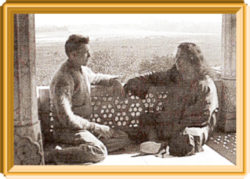The Life of Yogananda’s Secretary And His “Sparkling Travel Diary”
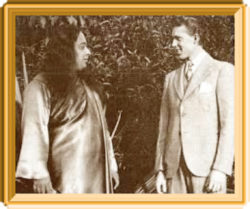
Clarence Richard Wright (9 Dec. 1911 – 9 Jan. 2002) is well-known to devotees of Yogananda as the young and faithful secretary who accompanied him on his visit to India in 1935/36. “At Ranchi, Calcutta, Serampore, everywhere he went, my secretary, who has a vivid gift of description, hauled out his travel diary to record his adventures,” Yogananda writes in his Autobiography of a Yogi. Several extracts from his diary have been inserted in the Autobiography, making it sparkle and shine even more brightly.
When visiting Giri Bala, the non-eating saint, Yogananda writes:
“More extraordinary grist for his travel diary! Not one of an average tourist, that!” Indeed.
But who was Richard Wright, called “Dick”?
Yogis reincarnated
First of all, he must have been a great yogi, reincarnated. Yes, he was born into a traditional Mormon family in Salt Lake City, Utah. But a strong yogic karma soon catapulted him in another direction altogether.
It happened when Yogananda, aged 38, began his Salt Lake City “campaign” on October 3, 1931, at the Hotel Newhouse. In the audience that night sat Richard (19 years), together with his mother Rachel, and his sisters Faye (17) and Virginia (16). This moment changed their lives forever. They were completely mesmerized.
Let’s take a closer look at these great souls, one by one.
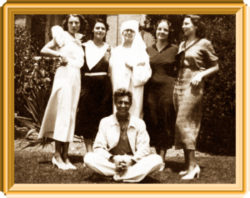 Richard Wright would later recall how Yogananda filled the auditorium with “tremendous force; his presence was unbelievably electrifying.” He, together with his mother and sisters, met the Master after his talk. They later attended every lecture in the series, and took every class they could. Richard was inwardly reawakened: he became a yogi and joined Yogananda at Mount Washington a year later, in late 1932.
Richard Wright would later recall how Yogananda filled the auditorium with “tremendous force; his presence was unbelievably electrifying.” He, together with his mother and sisters, met the Master after his talk. They later attended every lecture in the series, and took every class they could. Richard was inwardly reawakened: he became a yogi and joined Yogananda at Mount Washington a year later, in late 1932.
The only person of the family who wasn’t present during that magic evening was Richard’s father, Clarence Aaron Wright (1886–1967). The natural question is: what did he think about all that enthusiasm in his family for these Eastern teachings? And even more: how did he react when, one by one, virtually his entire family left home to join the Guru Yogananda? He remained all alone, so it seems, until his death in 1967.
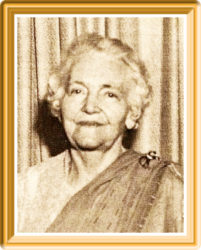 Richard’s mother, known as Shyama Mata (Rachel Leah Terry Wright, 1887–1972) was quite as electrified as Richard was by Yogananda’s dynamic presence and magnetism. That night everything changed for her: her life direction was now set. In 1935 she joined Yogananda in California, where her son and two daughters were already living. She spoke these amazing words to the Master: “Well, Paramahansaji, these are your children. I give them to you.” Yogananda therefore called her “great Mother”. She too was a reincarnated yogi, as one can see from Yogananda’s words to Daya Mata: “Your mother is indeed a yogi without ever having had to practice it.” Shyama Mata lived for 37 years as a nun in the SRF ashram. Her body was buried at Forest Lawn Memorial Park, close to Yogananda’s crypt. Daya Mata and her siblings wrote a beautiful inscription on her tomb: “Mother of our hearts. We found in your love the embodiment of God’s love.”
Richard’s mother, known as Shyama Mata (Rachel Leah Terry Wright, 1887–1972) was quite as electrified as Richard was by Yogananda’s dynamic presence and magnetism. That night everything changed for her: her life direction was now set. In 1935 she joined Yogananda in California, where her son and two daughters were already living. She spoke these amazing words to the Master: “Well, Paramahansaji, these are your children. I give them to you.” Yogananda therefore called her “great Mother”. She too was a reincarnated yogi, as one can see from Yogananda’s words to Daya Mata: “Your mother is indeed a yogi without ever having had to practice it.” Shyama Mata lived for 37 years as a nun in the SRF ashram. Her body was buried at Forest Lawn Memorial Park, close to Yogananda’s crypt. Daya Mata and her siblings wrote a beautiful inscription on her tomb: “Mother of our hearts. We found in your love the embodiment of God’s love.”
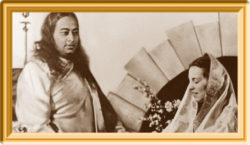 Another highly advanced yogi reincarnated was Richard’s famous sister: Daya Mata (Rachel Faye Wright, Jan. 31, 1914 – Nov. 30, 2010). She too was electrified, spellbound, and transformed by Yogananda’s powerful presence during that memorable evening in Salt Lake City. “As I stood at the back of the crowded auditorium, I became transfixed, unaware of anything around me except the speaker and his words. My whole being was absorbed in the wisdom and divine love that were pouring into my soul and flooding my heart and mind. I could only think, ‘This man loves God as I have always longed to love Him. He knows God. Him I shall follow!'” She received a further sign: after that conference Yogananda healed Daya Mata from a severe blood disorder. Previously, no doctor had been able to help her. “Him I shall follow” became the motto of her life, starting right away: only a month after her first meeting with Yogananda she went to Los Angeles and joined his ashram on Mount Washington (on Nov.19, 1931). So she was the first one of the Wright family to follow the Master. She actually became one of the very first nuns of his newly founded monastic order, in 1932, when she was only 18. Yogananda called Faye his “nest egg.” From 1955 until her death she served as the president of SRF. She was 96 when she left her body, after a lifetime of pure service and devotion.
Another highly advanced yogi reincarnated was Richard’s famous sister: Daya Mata (Rachel Faye Wright, Jan. 31, 1914 – Nov. 30, 2010). She too was electrified, spellbound, and transformed by Yogananda’s powerful presence during that memorable evening in Salt Lake City. “As I stood at the back of the crowded auditorium, I became transfixed, unaware of anything around me except the speaker and his words. My whole being was absorbed in the wisdom and divine love that were pouring into my soul and flooding my heart and mind. I could only think, ‘This man loves God as I have always longed to love Him. He knows God. Him I shall follow!'” She received a further sign: after that conference Yogananda healed Daya Mata from a severe blood disorder. Previously, no doctor had been able to help her. “Him I shall follow” became the motto of her life, starting right away: only a month after her first meeting with Yogananda she went to Los Angeles and joined his ashram on Mount Washington (on Nov.19, 1931). So she was the first one of the Wright family to follow the Master. She actually became one of the very first nuns of his newly founded monastic order, in 1932, when she was only 18. Yogananda called Faye his “nest egg.” From 1955 until her death she served as the president of SRF. She was 96 when she left her body, after a lifetime of pure service and devotion.
Richard had another, little-known sister: the third child of the family was Vanda Wright (1914-1920). Unfortunately, she died at the tender age of six. So Richard lost his little sister when he was just nine years old.
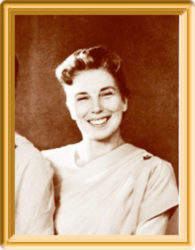 The fourth child of the family was another yogi incarnated: Ananda Mata (Virginia Lucy Wright, 1915-2005). She too must have been electrified by Yogananda’s presence when she first met him in 1931. The effect on her life, at any rate, was drastic and unequivocal: she joined Yogananda not long after Daya Mata, and became a nun of the SRF Order in 1933. She too was only 18 then. Throughout her life she served Yogananda quite as intensely as her sister and became the secretary and treasurer of the SRF Board of Directors.
The fourth child of the family was another yogi incarnated: Ananda Mata (Virginia Lucy Wright, 1915-2005). She too must have been electrified by Yogananda’s presence when she first met him in 1931. The effect on her life, at any rate, was drastic and unequivocal: she joined Yogananda not long after Daya Mata, and became a nun of the SRF Order in 1933. She too was only 18 then. Throughout her life she served Yogananda quite as intensely as her sister and became the secretary and treasurer of the SRF Board of Directors.
Richard’s younger brother, the fifth child of the family, was born much later: Samuel Dale Wright (1924-1987). He was a mere boy of 11 when he came to Mount Washington with his mother in 1935. Dale wasn’t quite ready for being spiritually educated, however. Swami Kriyananda recounts in The New Path: «Master told me many stories about people—students, chance acquaintances, and disciples. One that springs to mind was about Dale Wright, Richard’s younger brother. “Every time I tried to help him with advice, he whined to his mother, ‘Mommy, he’s scolding me!’ At last I gave him a toy airplane. He loved it! In fact, it settled him in his life direction: When he grew up, he became an aeronautical engineer.»
Precious time with Yogananda
Richard Wright was a dynamo during those early years with the Master. He acted as Yogananda’s personal secretary and provided yeoman editorial service on the first set of Praecepta (SRF Lessons), in 1934.
Yogananda described him in glowing terms: “Of all workers I find Dick Wright the most intelligent, faithful…. About weekly Praecepta, I told Dick what you [Rararshi Janakananda] thought of them and it made him very happy.”
One thing seems certain: Yogananda had great plans for Richard. In 1934, in a personal letter to Richard Wright, Yogananda wrote how he envisioned Richard’s life:
“So happy, at last I found a little band of youngsters—your family—who have given me more happiness and confidence than anyone else in being the foundation of this work for which I have bled for years and sacrificed everything. I hope you realize how much I think of you all; and while I am living, and more when my lips will be silent forever, you will have a chance to prove that you will live and die for this great work. That alone can be the best token of you and your sisters’ loyalty. You all must be one with me.”
Indeed, when Yogananda incorporated SRF in 1935, he appointed Richard to the first Board of Directors, and the position of corporate Secretary. It was a more important position than even that of Daya Mata. The directors of the Church were:

Yogananda (President); Gyanamata (Vice-president); Richard Wright (Secretary); Durga Mata (Treasurer); Karla Schramm. Their signatures of the incorporation are shown above (Durga= Florina Darling; Gyanamata = Edith A. Bissett).
In India with his magic travel diary
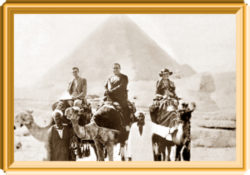 Later that same year, Yogananda left for his sixteen-month triumphal return to India, via England, Germany, Italy, Greece, Israel, Egypt. He took “Dick” with him as his personal secretary. All along, Richard Wright wrote what Yogananda calls in his Autobiography of a Yogi a “sparkling travel diary,” praising him for his “vivid gift of description.”How highly Yogananda thought of his travel diary can also be seen by the amount of material he included in his Autobiography, which are the following incidents:
Later that same year, Yogananda left for his sixteen-month triumphal return to India, via England, Germany, Italy, Greece, Israel, Egypt. He took “Dick” with him as his personal secretary. All along, Richard Wright wrote what Yogananda calls in his Autobiography of a Yogi a “sparkling travel diary,” praising him for his “vivid gift of description.”How highly Yogananda thought of his travel diary can also be seen by the amount of material he included in his Autobiography, which are the following incidents:
– The meeting with his Master, Sri Yukteswar
– Their visit to the sadhus at the Kumbha Mela
– Their visit to Mysore
– Their visit to Giri Bala
When visiting Mahatma Gandhi, Mr. Wright’s travel diary received a unique blessing. We read in the Autobiography of a Yogi:
“Observing Mr. Wright’s travel diary, Mr. Desai opened a page and wrote on it a list of Satyagraha vows taken by all the Mahatma’s strict followers (satyagrahis): ‘Nonviolence; Truth; Non-Stealing; Celibacy; Non-Possession; Body-Labor; Control of the Palate; Fearlessness; Equal Respect for all Religions; Swadeshi (use of home manufactures); Freedom from Untouchability. These eleven should be observed as vows in a spirit of humility.’ (Gandhi himself signed this page on the following day, giving the date also–August 27, 1935.)”
In other words, Mr. Wright’s precious travel diary even contains Gandhi’s personal signature.
It also contains Yogananda’s handwriting. In the Autobiography we read:
“Giri Bala fell into silence. I took Mr. Wright’s pencil and pad and translated into English a few items for his information.”
Of course, his travel diary must contain many more interesting stories, facts, and observations. Swami Kriyananda writes for example in his book, The New Path: “In 1935 Master visited Stonehenge in England. To his secretary, Richard Wright (Daya Mata’s brother), he remarked quietly, ‘I lived here myself thirty-five hundred years ago.’”
Does this unique travel diary still exist, maybe in SRF’s secret vaults? If so, maybe in the future more of it will be shared.
Here we see Therese Neumann, Mr. Wright, Yogananda speaking with Professor Franz Wutz, mentioned in the Autobiography of a Yogi. (According to Wikipedia Mr. Wutz was both a priest and a professor for the Old Testament.)
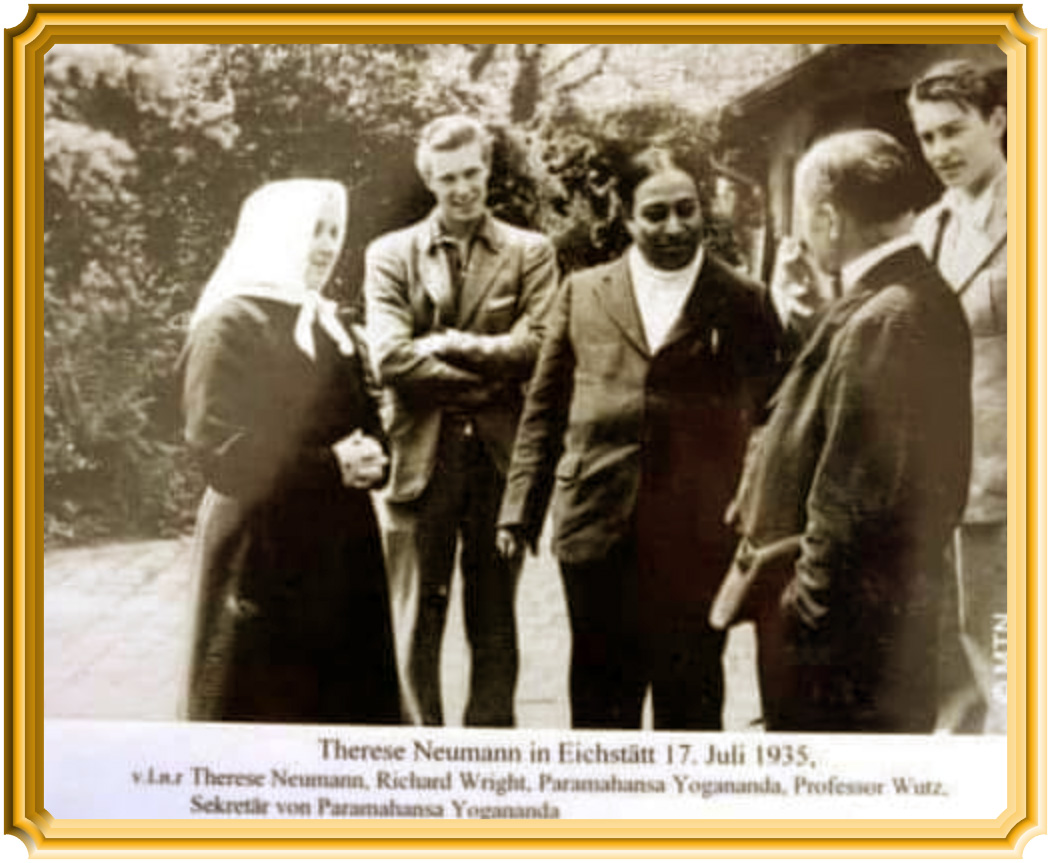
Photos and videos
Richard Wright also took many photos, for example the one we know of Giri Bala.
And more! In his Autobiography, Yogananda says:
“‘Please, Ananda Moyi Ma,’ I said, ‘come with me to the garden. Mr. Wright will take some pictures.’”
In fact there is a lovely picture of Ananda Moyi Ma leaning on Yogananda’s shoulder, thanks to Richard Wright.
He also took videos! Yogananda writes in his Autobiography:
“Mr. Wright also took moving pictures of Sri Yukteswar during his last Winter Solstice Festival in Serampore.”
And:
“Meekly [Giri Bala] approached and silently assented to our snapping a number of pictures with our ‘still’ and ‘movie’ cameras.”
In other words, apart from the videos which SRF has published, various other unpublished films still exist, for example of Giri Bala and of the Serampore Festival.
In his book Mejda, Sananda Lal Gosh describes how Richard was not only the constant and valiant driver of the Ford, but also how he took on many duties to help Yogananda during his heavy schedule of lecturing, meeting with devotees and administration work for the Yogoda Society. After each lecture, he answered inquiries and took down the names of persons interested in becoming students.
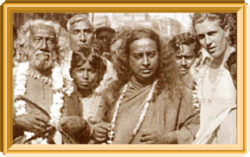 Richard observed how different Yogananda became when he was lecturing: how he “radiated tremendous power and wisdom.” Otherwise he was just a simple and joyous person, like a child. It is always a challenge to bear in mind who a Master really is when you see him daily expressing his normal personality.
Richard observed how different Yogananda became when he was lecturing: how he “radiated tremendous power and wisdom.” Otherwise he was just a simple and joyous person, like a child. It is always a challenge to bear in mind who a Master really is when you see him daily expressing his normal personality.
At any rate, Sananda had only the highest praise for Richard, saying that he was “extraordinary,” and that he had never met such a hardworking and obedient young man. Even when returning late at night after a strenuous day of engagements, he never missed any opportunity to serve Yogananda.
However, he also describes a situation when Richard simply left Yogananda in the midst of all his engagements to go and see a circus. Yogananda sent Sananda to find him and pull him out of the circus and then scolded him sternly: “You will spoil the work I am trying to do on this visit to India if you are not here when I need you.” After that Richard Wright returned to once again being the diligent and serviceful disciple.
Return to the USA, marriage, and separation
Soon they were on their way home. Yogananda and Richard (together with Miss Bletch who too was part of the India journey), before returning to the USA, paid a second visit to England. After that he writes in his Autobiography:
“Our little party sailed from Southampton for America in late October on the Bremen. The majestic Statue of Liberty in New York harbor brought a joyous emotional gulp not only to the throats of Miss Bletch and Mr. Wright, but to my own.”
Unfortunately here a different karma kicked in. In “Conversations with Yogananda”, Swami Kriyananda tells the sad story. He omitted names. They are, however, included here in brackets.
The Master once, in speaking of a certain woman disciple [Shyama Mata], told me, “I used to call her ‘Great Mother.’ She had given all her children [Richard, Daya Mata, Ananda Mata, Dale] here for training. They weren’t all ready for our way of life [Dale], but she had great faith in me. The oldest boy [Richard] was very sincere, though he lacked the spirit you all show. If, for instance, I asked him to fetch me a glass of water, he might reply, ‘I’m busy now. Can you get it yourself?’ He returned once from a long voyage [to India, with Yogananda]. A young woman ‘fell for him,’ as the expression is. She saw him through a romantic haze as ‘the great world traveler.’ He and I were together in New York when he announced to me one day, ‘I have to make a short visit to Philadelphia.’ ‘To buy a ring?’ I challenged him. ‘You don’t know anything about her,’ he replied defensively, well aware of whom I was referring to. I said, ‘I know everything about her!’ Well, he found out. He hasn’t had a day of happiness since he got married. It will take him incarnations to become freed of this karma. His mother, when she saw his desire to get married, sided with him against me. My wish was to spare him great suffering, but her reaction was what most mothers’ would have been in matters like this. Since then, I have never called her ‘Great Mother’ again.”
In The New Path, Swami Kriyananda tells the same story, adding: “Master’s eyes expressed sorrow for his erring disciple.”
A happy family reunion
In a letter by Yogananda, printed in Durga Mata’s book Trilogy of Divine Love, one can track where Yogananda went after landing in New York: “September 11, 1936 – Starting from London October the 3rd, reaching New York October the 8th, then two days in Boston [Dr. and Mildred Lewis], then to Kansas City [Rararsi Janakananda], then to Mt. Washington.”
Richard made his “short visit to Philadelphia.” In early November 1936 they drove westward in their Ford. They stopped in Utah. Why? Yogananda had planned a very special meeting there.
From New York he had telephoned Mount Washington, organizing that loving meeting for Nov.16, 1936, in a most auspicious spot: in the Newhouse Hotel in Salt Lake City, where the entire Wright family had experienced their life-changing first meeting with Yogananda. Now the Master had invited them all back there: Daya Mata, Ananda Mata and their Mother Shyama Mata. Along came Durga Mata and Sister Sailasuta. The story is described in Durga Mata’s book, A Paramhansa Yogananda Triology of Divine Love.
It was a moment of great happiness, of “ice-cream and chocolate fudge,” but Yogananda said very little, as “he was inwardly busy analysing each one’s soul.” He then requested a private interview with each one of them. He asked Durga Mata: “Duj, do you still love me?” She threw herself at his feet and cried her answer. Yogananda in fact had said that he had felt a great temptation to stay in India: it was only the love for his American disciples which brought him back to the USA.
At any rate, there at the hotel, his mother and sisters must have heard of Richard’s trip to Philadelphia and his marriage plans. His mother supported him, “and sided with him against me [Yogananda].”
Back at SRF
The blessed group remained in Salt Lake City for a few days, as Durga Mata writes. Then they drove to Zion Canyon (a National Park), to see “all the sites” there.
Afterwards Yogananda wanted to go to San Francisco, “to see if he could persuade Tara Mata to come back to Mount Washington to work with him on his books.” His efforts were successful.
Concerning Richard: back at SRF, did something maybe start to shift in him, after Yogananda’s disapproval of his marriage plans?
At any rate, according to official data, he was married in Los Angeles on May 06, 1937 to Helen Louise Ewing (1914-1970). It appears to have been his first wife.
Interestingly, even after his marriage he continued to live in SRF, presumably with his new wife. He received further leadership positions.
Now, however, he didn’t get to spend as much time with the Master anymore.
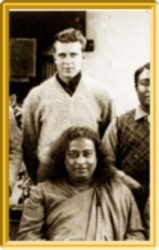 SRF (in an article “C. Richard Wright-In Memoriam, SRF magazine, Spring 2002”) writes: “After returning from India, when Paramahansaji was spending most of his time his newly acquired Hermitage in Encinitas, Mr. Wright was placed in charge of offices and personnel at Mount Washington. In 1937 he was elected as Treasurer of SRF, and hence served as Secretary and Treasurer for the next four years. In January 1941, with the blessing of Paramahansaji, Mr. Wright resigned from the Board of Directors, having assumed the responsibilities of a householder, and began a long and distinguished career as an aerospace engineer with Lockheed Corporation.”
SRF (in an article “C. Richard Wright-In Memoriam, SRF magazine, Spring 2002”) writes: “After returning from India, when Paramahansaji was spending most of his time his newly acquired Hermitage in Encinitas, Mr. Wright was placed in charge of offices and personnel at Mount Washington. In 1937 he was elected as Treasurer of SRF, and hence served as Secretary and Treasurer for the next four years. In January 1941, with the blessing of Paramahansaji, Mr. Wright resigned from the Board of Directors, having assumed the responsibilities of a householder, and began a long and distinguished career as an aerospace engineer with Lockheed Corporation.”
When Richard left SRF, he was still a young man, having just turned 29. For a little over eight years (late 1932 – Jan. 1941), he had been a close assistant of Yogananda, interacting with him as few others have. At times they even shared a room when touring together, as Yogananda relates in a discourse. Now “Dick” was gone. He pursued his career and became a father, as the SRF article states: “Mr. Wright is survived by three sons and a stepdaughter”, (implying that he married a woman who already had a daughter, or that his wife later conceived a daughter from another man.)
The return home after 60 years
Richard Wright, as Mrinalini Mata shared, came to visit Mount Washington or Encinitas many times, for a family reunion. His support was felt, inwardly. Outwardly however, he wasn’t active for SRF anymore.
Yogananda had once told Daya that “the time will come when Richard needs help. Look after him.” Indeed, after almost 60 years of living apart from SRF, at the end of his life he fell ill and his wife was not able to take care of him anymore. Richard was welcomed back into SRF, living for two years with the monks, one of whom acted as his nurse.
Mrinalini Mata (who joined SRF in 1946, five years after Richard had left), in a discourse, shared what was maybe the general feeling of everyone, concerning Richard Wright: “…in these last two years, I am sure, [Master] was saying to him: ‘My dear, dear, beloved son, you are back in the home where I have wanted you to be.’”
He was greatly appreciated and loved, even when infirm and weak.
Shortly before Christmas 2001, he told his nurse that he would be there for the holidays, but then “I am going home.” Indeed, this is what happened! Leaving his earthly home, he passed on to his heavenly home on Jan. 9, 2002, just one month after his 90th birthday.
It seems a beautiful symbol that in death his body remains close to Yogananda: both are buried at the Forest Lawn Memorial Park.
The moral for devotees
What is the moral of this story for devotees? Yogananda obviously wanted Richard Wright to be “home”, and “live and die for this great work.” He probably was meant to be a sparkling torchbearer for SRF and would certainly have played a major role after the Master’s passing had he stayed. It is even rumoured that he was destined to have become the SRF president. Yet he left, married, and lived far from Yogananda: too far, even though throughout his life he continued to support SRF.
Tara Mata seems to have been somewhat smarter. She too left SRF (1929), married and had a daughter, Mona. But she realized her error and returned (1936). When fellow disciples asked how she dared to show herself again in the monastery, having once left it, she answered vigorously, “Do you expect me to worship my mistakes?”
Fortunate indeed are those who, having realized their mistake, abandon it and return resolutely to the divine search.
So the point is this: most of us, at a certain point in our life, will drift, will get distracted, or will get lost in spiritually unwholesome directions.
Once we realize it, we should never think “it’s over,” or despair, or get discouraged, but firmly return to the dharma of our soul. What else can we do?
Our dharma might very well require of us to be married and to have a family. Not marrying is not the point of the story. But in our heart nothing should ever come before God and Guru: no person, no career, nothing.
Fortunately it is written in the Bhagavad Gita (2, 40): “On this path no effort is wasted, nor is there any danger of adverse effects.” In other words, every good action we have done remains good and is never wasted.
So let’s not remember Richard as a prodigal son, but rather remember him with a deep sense of gratitude for what he created with his pen, his camera and his videocamera. It is his special gift to the world and to all of us. And it will not be wasted.
Thank you, Richard Wright!
